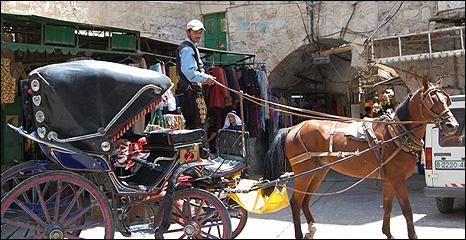
Horse-drawn buggies brighten tense W.Bank city
HEBRON, West Bank (Reuters) - Sitting proudly atop a brightly painted horse-drawn carriage, Kassem Ahmaro cuts an odd figure as he trots past army bunkers and graffiti reading “Kill Arabs” into the heart of Hebron’s old city.
Palestinians wait for customers in their horse-drawn carriages in the West Bank city of Hebron April 15, 2008. REUTERS/Nayef Hashlamoun
The buggy might seem like a gimmick more suited to New York’s Central Park than the Israeli-occupied West Bank.
But it is part of a Palestinian drive to revive Hebron’s historic centre, where routine life and economic activity have been virtually halted by about 650 Jewish settlers -- some of the West Bank’s most militant -- and the Israeli soldiers who guard them.
“We are trying to revitalize life in the old city,” said Emad Hamdan, head of the Hebron Rehabilitation Committee (HRC), which brought the carriages to the city.
“Parts of Hebron have been reduced to a ghost town and we are trying everything we can to bring Palestinians back.”
Home to the grave of Abraham, revered by Jews, Muslims and Christians alike, Hebron has seen some of the region’s bloodiest violence.
Tensions run high between Hebron’s 180,000 Palestinian residents and tiny enclaves of settlers, who say they are restoring a Jewish community which left after a 1929 massacre in which scores were killed by Arabs.
Helmeted Israeli soldiers stand guard on street corners.
The old centre once heaved with shoppers but rights groups say Israeli restrictions and harassment by settlers have forced out thousands of Palestinian residents since an Intifada, or uprising, began in 2000.
Many shops are now shuttered and deserted alleyways are dotted with bullet-proof bunkers and military watchtowers, which Israel says are needed for security reasons.
Palestinians are banned from taking cars into the centre.
SETTLER-STYLE TACTICS
With tactics reminiscent of those used by the settlers themselves, the HRC -- funded by the Palestinian Authority and European donors -- is trying to reclaim the city by revamping old buildings and letting Palestinians live there for free.
Prime Minister Salam Fayyad has offered to pay local merchants $200 a month to open shops in the abandoned market. A few now sell embroidery, spices and household staples.
The fleet of horse-drawn carriages, which started ferrying passengers around the old city just over a month ago, is the latest Palestinian weapon against settler encroachment and Israel’s network of roadblocks, gates and checkpoints.
Hamdan hopes the novel mode of transport will attract visitors, but more importantly, encourage local shoppers to make the trip, which can take 20 minutes on foot, from the edge of the old city where cars must stop into the centre.
“There’s no transport in the old city so it’s nice,” said 22-year-old student Isa Frokh as he clambered into the buggy. “I use the carriages to do my shopping and to go and pray at the mosque -- I probably go more often now I don’t have to walk.”
Horse-drawn buggies brighten tense W.Bank city | Reuters
